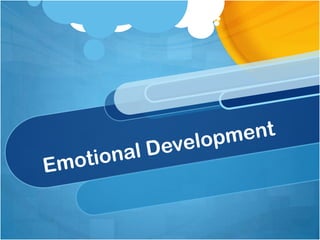
09 emotional development
- 2. Fear Infants: actual/unusual objects Preschool years: the imaginary, anticipated or the supernatural Children’s crying and overt signs of fear decrease as they grow older, but continue to be afraid of imaginary creatures
- 3. Fear (cont’d) As they mature, it is the foreseeable real-life possibilities which frighten them. During the 80s, 85% of West Aust. Pupils aged 11-17 feared being destroyed in a nuclear disaster
- 4. Happiness Most of childhood is generally a time of fun, laughter and happiness. Many of the things that make them happy are similar to what makes adults happy – being successful, the company of friends, playing games or sport, given presents, going out for a treat.
- 5. Anger At 2 yrs, kicking, pounding, screaming and tantrums are common. Between 4-5, they can express some of their anger and frustration verbally, rather than just physically Can lead to shouting and threats rather than actually hitting others.
- 6. Anger (cont’d) May direct anger at inanimate objects Most children have fewer anger outbursts than infants, but the length of rage and sulking increases with age. 5-7 yrs respond as angrily to unintended frustrations as they do to deliberate provocations. Older childrenareusually only angered by the latter.
- 7. Jealousy Often when a baby sibling is born Does not always occur, but is common among first-born
- 8. Overcoming jealousy Can be overcome if the older child is made to feel secure by being given love and attention and understand that the new addition does not mean less love for him/her. Involving the older child can also help.
- 9. Regulating Emotions Regulation is necessary when emotions are too distressing, overwhelming or needs to be amplified. Children can regulate: Cognitively(e.g. convincing themselves there is nothing to be anxious about or refocusing on less anxiety-provoking thoughts) Behaviourally (e.g. by smiling to make themselves feel less anxious)
- 10. Regulating Emotions (cont’d) With time, primary school children learn that goals are not always met by expressing their most intense feelings (e.g. regulating anger because of its negative consequences) According to Denham et al (2002), emotional expression now depends more on the person with whom, and the situation in which, children are interacting
- 11. Emotional expressions In infancy and childhood, the two most common are the smile and the crying. Two types of smiles: reflexive and social
- 12. Smiles (cont’d) Reflexive appears in the first month after birth, usually during irregular patterns of sleep and not when the infant is alert. Social smile occurs in response to external stimuli and occurs at around 4-6 weeks.
- 13. Crying CRYING Four types: rhythmical cry – also known as hunger cry angry cry – forces excess air through the vocal cords pain cry – sudden onset of loud crying cry of frustration – first two or three cries are long and drawn out
- 14. Table 1: Arrival times of infant emotional expressions (adapted from R.J. Trotter, 1983)
- 15. Sex differences Parental encouragement of emotional expression may vary Stoneman and Brody (1993) found: 1) Expressions of negative emotions generally is considered more acceptable for girls than boys 2) The encouragement of moderate emotional expressivity may be particularly linked to boys’ social functioning. Therefore, research suggests that there may be sex differences in parents’ encouragement of emotional expressivity in their children